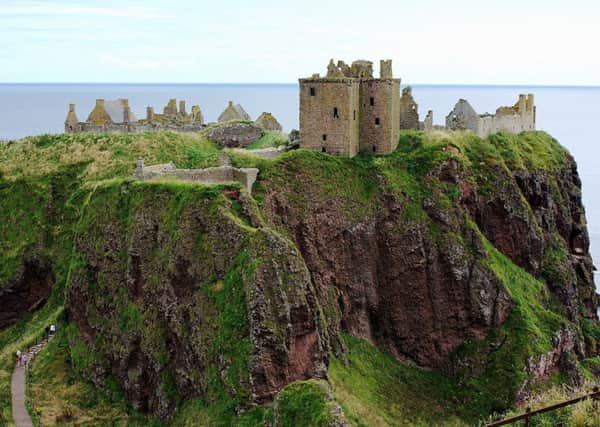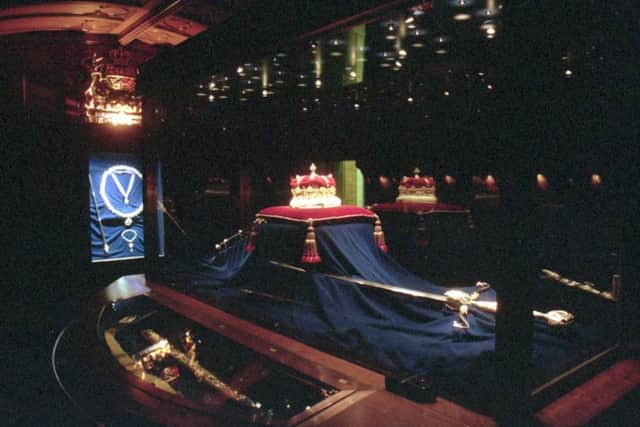The women who smuggled Crown Jewels from Dunnottar Castle


As a result, the Honours were hidden under a bed in a nearby manse before being buried under the pulpit at Kinneff Church where they remained for nine years.
The Crown, sword and sceptre, the oldest Royal Regalia in Britain, were moved to Dunnottar near Stonehaven for safekeeping following the coronation of Charles II on January 1 1651.


Advertisement
Hide AdAdvertisement
Hide AdThey were hidden in sacks of wool by Katherine Drummond of Moneydie, Perthshire and carried to Aberdeenshire through territory occupied by Cromwellian forces.
But with Cromwell’s army advancing north, their safety could not be guaranteed for long and in September 1651, Dunnottar, home of the Earl Marischal, was besieged for eight months.
Four women laid out an audacious plan to move the Honours under the nose of the army with a female servant to assist in the mission.


Christian Fletcher, wife of James Grainger, minister at Kinneff Church, was to ultimately move the jewels from the castle.
Advertisement
Hide AdAdvertisement
Hide AdHer mission was executed with the help of Mary Erskine, dowager Countess Marischal and Elizabeth Douglas, wife of castle governor George Ogilvie of Barras.
Anne Lindsay, a friend of Douglas, launched the rescue by walking out of the castle with the King’s papers sewn into her belt.
Fletcher, who was to later give an account of her actions to the Privy Council, claimed to have visited the castle three times to remove the honours.
In February 1652, she collected the crown and sceptre, made of solid silver and encrusted with a crystal globe, a rock crystal and a Scottish pearl, from Douglas.
Advertisement
Hide AdAdvertisement
Hide AdThe minister’s wife took them away on horseback, riding close to the cliffs ready to tip the pieces into the sea if pursued.
The following month, she went on foot with a servant, the sixth woman, who took away the sword in a sack of coarse flax on her back. A friend of the governor’s wife and herself married to a minister, Fletcher attracted little suspicion as she headed into the castle compound with her assistant.
The sword case was later hidden in a sack of pillows with all the pieces moved to the manse at Kinneff, around six miles away.
Fletcher’s account to the Privy Council was considered too boastful by some with another version of events later emerging in the 18th Century.
Advertisement
Hide AdAdvertisement
Hide AdRecounted by William Meston, tutor to the family of the Earl Marischal in the 18th Century, it was claimed that the crown and sceptre, and perhaps also the sword, were lowered from the castle to the beach below where Fletcher’s servant girl took them away hidden in a creel of seaweed.
The name of the servant remains unknown.
What is clear is that Fletcher and her husband buried them in Kinneff Church.
Dunnottar surrendered on 24 May 1652, the last place in Scotland where the Royal flag still flew, with the Cromwellians finding the Honours had gone when they took the castle two days later.
It was claimed that John Keith, son of Countess Marischal, had taken the Honours to the Continent and the hunt was discontinued.
Advertisement
Hide AdAdvertisement
Hide AdEvery three months, Fletcher and her husband, working at night, levered the Honours from the ground, aired them, and reburied them in fresh cloths.
They surrendered them after protracted negotiations on October 8 1660 but a bitter row was to break out among the circle of women over who played the biggest role in their rescue.
The Countess Marischal secured money and titles for her son by falsely insisting that the story of his having smuggled them to the continent was true.
Douglas secured a lesser reward by claiming the main role in saving the Honours.
Advertisement
Hide AdAdvertisement
Hide AdAmid the row, the role of Fletcher, her husband and the servant was diminished.
However, the Scottish Parliament later recognized that Fletcher had been ‘most active’ in conveying the honours to safety and then preserving them from the ‘English usurpers’.
She was awarded a sum of 2000 Scots merks - but the money was never paid.
Fletcher’s story gained fresh attention after the Honours, which had laid in Edinburgh Castle since 1707, were rediscovered in 1818 by Sir Walter Scott.
Advertisement
Hide AdAdvertisement
Hide AdHer account was depicted by painter Alexander Chisholm’s in his work The Minister of Kinneff and his Wife Concealing in the Church the Scottish Regalia was exhibited at the Royal Academy in 1846.
Fletcher was also cited in the Girl Guides handbook in 1912 by Lady Agnes and Sir Robert Baden-Powell as an example of bravery and patriotism.
